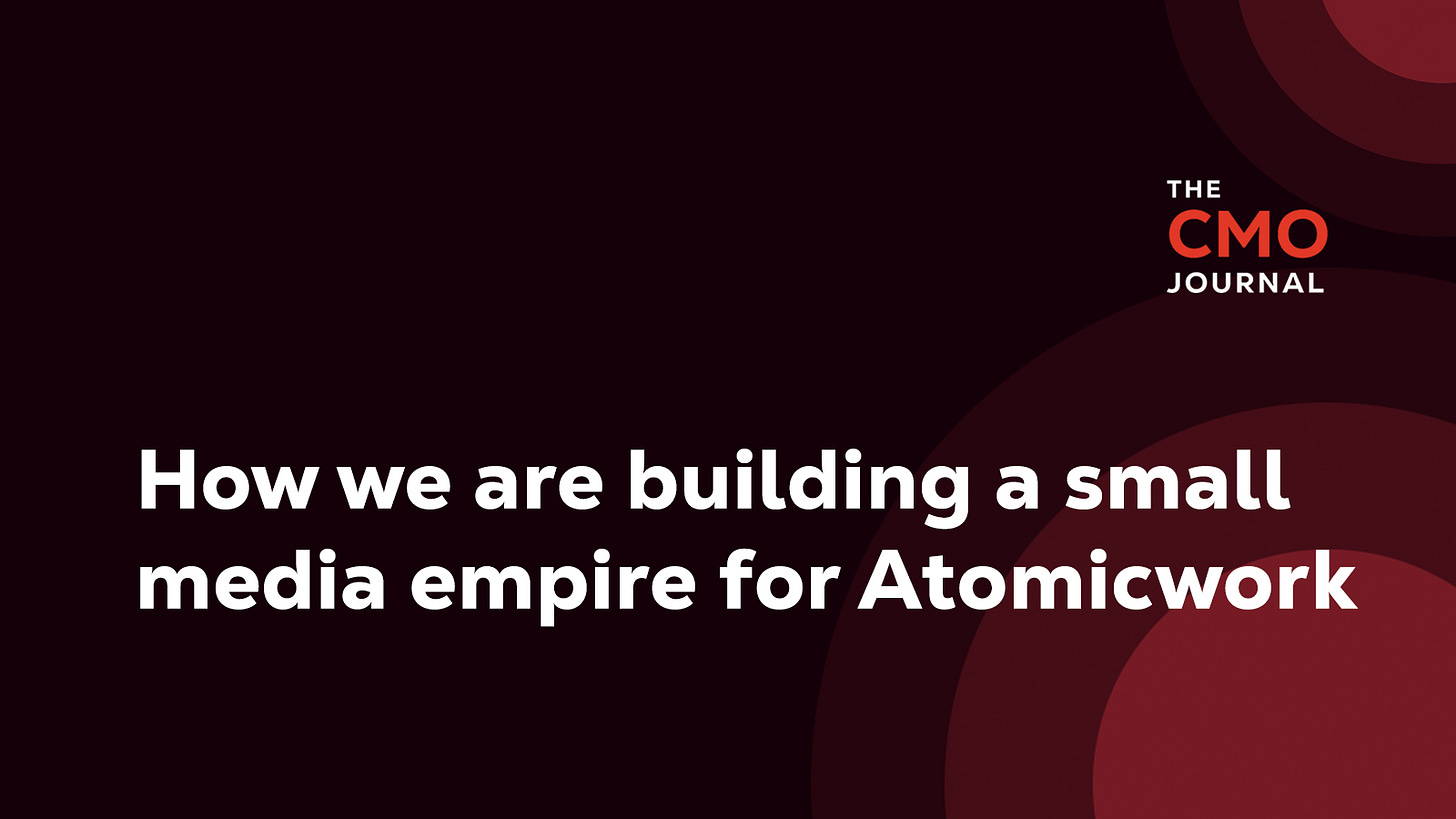How we are building a small media empire for Atomicwork
And why patience and repetition are the two secret ingredients of brand building
To tell you this story, I have to set the scene. At Atomicwork, we ran out of office space a month or so ago. And to make way for new engineering folks, marketing moved to the two meeting rooms we had on the terrace. It’s cramped and hot, and the air conditioners give up sometimes. There’s no soundproofing, so everyone hears what everyone else is talking, even through the wall. But I would be lying if I said we aren’t enjoying it. There is a closeness to the team now, a camaraderie borne not just out of what we are trying to do together, but also out of being basically inches away from each other. We have no choice except to get along and get things done.
It is in this setting last Friday that I suddenly had a brainwave, and called out a question to my colleague in the next room: How many content IPs do we have now?
We started counting, and this was the list we made:
The Atomicwork Blog, a little more or less than 150 articles in there
Atomic Conversations, our podcast, which now boasts both audio and high quality video productions
Our social channels - Twitter, LinkedIn, and Instagram, which we treat as entities of their own, especially LinkedIn
Letters from a former CIO, a newsletter for IT professionals written by Lenin Gali, Atomicwork’s Chief Business Officer
Reports, like The State of AI in IT for 2024, and 2025, and The Buyer’s Guide to ITSM
Apart from this, we have things like our product newsletters, webinars, our customer communications, and our founders’ social channels, especially LinkedIn. We don’t work on their social channels ourselves, but as a company we understand their role in our company comms.
Why was I suddenly thinking about this, and what is the point of this list?
Because I realised I had actually done something I always wanted to do - build a set of IPs for a startup that compound, working almost like a media company for the brand.
I have been thinking about this for a long time, have believed in the idea for longer, and have also tried and failed a couple of times. But the team and I have at last managed to get this right at Atomicwork, and laid a strong foundation on which to build on.
Why is this important to do? I’ll give you three reasons.
For an executive to trust a brand, especially a startup, there need to be several touchpoints before they make a decision to engage. The signals have to be there for them to see you as legit.
Second, for them to think you know what you are talking about, you need to help them do something at work that’s important to them, or show that you understand their problems. The easiest way to do both of the above is content.
Third, as a startup, you need to look like you are a bigger company than you are for an enterprise to trust you and your product. The quality and presentation of your content go a long way here.
This is why the work we have done is gratifying, not just because we understood the assignment, but because we have also managed to execute. And experienced hands know the huge gap between knowing what needs to be done and actually being able to do it.
The reason for the gap is nuanced. It’s not just me who knows that this is a good approach to brand building. Almost every good marketer does. But for this to be executed, you need a CEO who gets marketing, is willing to spend money and time on it, and trusts the process. It took me and my team more than two and a half years (and a whole lot of luck) to get to this point, I needed that backing. And only if we do this another 5 years continuously can this motion even remotely be called a success. That’s the difficulty, that’s the nuance. Don’t have that kind of patience, either you or the leadership? Don’t even start.
Next, you need a team that can execute on both speed and quality, and also understands that repetition is a huge part of marketing: You need to show up again and again and again. Your team need to make the hundreds of small decisions that keep the engine moving. One person cannot do all of this. So you need to hire well, give them the right tools and strategies. And finally, you need a great product to do it for. No amount of great marketing can make a poor product successful. For all of these stars to align takes a lot of come together.
This is also why I’m looking forward to the beginning of this next phase at Atomicwork, as we try to accelerate this. We do not really know if it will work at the scale I think it will. But my team and I have put ourselves in a position to find out.
Dear readers, as I wrote in the last couple of newsletters, we are nearing the 5th anniversary of The CMO Journal, and I’m putting together a WhatsApp group of marketers/founders/enthusiasts who are readers. If you’d like to be part of this group, please email me at sairamkrishnan@outlook.com, and I’ll add you as we create it.
I’m also thinking of a get-together of readers in Bangalore. If you’d like to come meet me and more readers, please email me at sairamkrishnan@outlook.com.
And if you are new here, do subscribe! Q2 is going to be a busy period of writing, and it’s a good time to join the almost 5000 subscribers that get this newsletter every week in their inbox.

